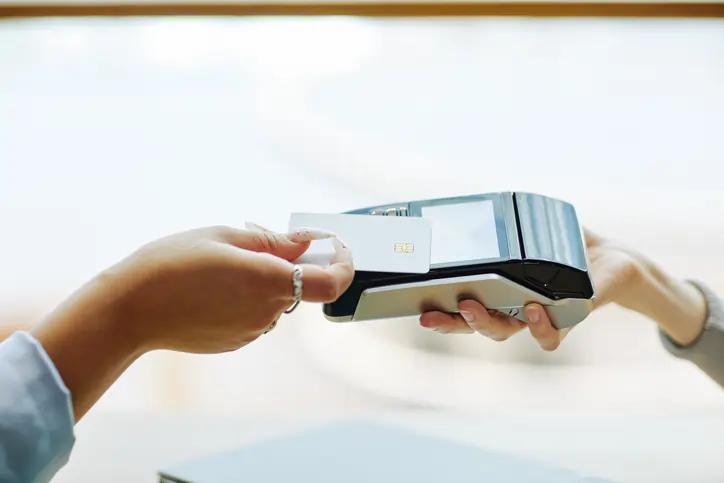The Cashless Economy: How Digital Payments Are Transforming Transactions
The Cashless Economy: How Digital Payments Are Transforming Transactions
Published by Jessica Weisman-Pitts
Posted on February 19, 2025

Published by Jessica Weisman-Pitts
Posted on February 19, 2025

Physical banknotes are slowly making their way out of the picture when it comes to commerce in a cashless society. Tapping a card, scanning a phone, clicking ‘check out’ for an online cart; these digital transactions can take place in seconds from the comfort of one’s home. The focus of businesses and consumers alike has recently been redirected to adapt to this financial phenomenon. It’s important to remember, though, that digitizing payment processes is about more than just convenience. The dynamics of cash flow in a tech-based society must be considered in order to regulate business performance.
Mobile applications enable fast payments, a key factor for surviving the competitive financial market. Today, you can send money instantly, pay bills with a swipe, or split expenses without having to touch a check or a dollar bill. In-store card payments double the efficiency of the check-out process; without the hassle of pulling out a card and swiping or keying in a PIN, shopping environments have the potential to become much faster for busy individuals. In regard to e-commerce, online shopping has made it easy to buy a variety of products from around the world. In 2024, the number of digital buyers stands at 2.71 billion, showing consistent growth in online shopping. This marks an increase of 70 million from the previous year, representing a 2.7% year-over-year growth.
In brief, these changes are restructuring the transactional dynamics of both businesses and consumers. Let's take a moment to consider the effect that mobile applications, contactless cards, and online payments could have on our economy as a whole. The turbocharged efficiency of digital transactions can have the potential to lead to problems like demographic inequalities and security issues; while convenience is a significant factor to consider, ethics also plays a large role in determining the success of an organization. With this in mind, let’s break down step-by-step what digital payments could do for our financial future.
The Rise of Digital Payments
The transition from cash to digital is not just about trends. It’s about a departure from old ways of buying, selling, and transferring money. Digital payments have already begun to change the nature of transactions; whether tapping a card at the check-out or ordering groceries online, nearly all forms of payment are super convenient for the customer’s comfort. As most modes of business have grown adept at digitizing their transactions, consumers everywhere are able to access their spending without the hassle of waiting in a physical queue.
It is useful for businesses looking to gain a competitive edge to study how digital payments are reshaping transactions through tools like mobile wallets, contactless card convenience, and online shopping. It will be necessary to remain flexible as financial ease reaches newer, higher levels.
1. Mobile wallets in daily transaction
Mobile wallets have transformed the way we pay, replacing traditional methods with convenience and innovation. By simply tapping a smartphone or smartwatch, users can complete transactions without the hassle of cash or cards. These tools not only simplify payments but also integrate advanced security features like encryption, making them a trusted choice for modern consumers.
For instance, Apple Pay allows iPhone users to make payments with Face ID or Touch ID in a seamless, straightforward process at checkout. Google Wallet, a feature supported on Android devices, offers a similar level of customer-oriented ease. On a universal level, PayPal has become the all-around method of payment for online purchases and person-to-person transfers, enabling instant money transfers without the need for a bank transfer. Such applications work to promote fast payments in a secure, multifaceted manner through the use of tools like encryption and fraud mitigation.
2. Contactless cards as a retail productivity tool
Tap-to-pay cards are making traditional card swipes and chip inserts feel outdated to most younger generations. With contactless technology, users simply hold their cards near a terminal to complete a transaction in mere seconds. Major banks and credit card companies like Visa, Mastercard, and American Express have rolled out contactless cards as a standard option. Businesses also benefit functionally; faster checkouts mean shorter lines and more sales for customers who are in a hurry.
Retailers in the fast food market have adopted tap-to-pay systems, cutting down transaction times and improving customer experience. For consumers, the convenience of not having to enter a PIN or sign a receipt makes payments more efficient. Additionally, in an environment like fast food, tap-to-pay enables a more sanitary option for paying without the exchanging of physical cash or a card, both of which are prone to carry germs.
3. E-Commerce & online payments
The rise of online shopping has made digital payments more essential than ever for major retailers around the world. E-commerce giants like Amazon and Target rely on secured payment gateways to manage millions of daily transactions. Holidays like Cyber Monday rely solely on the optimization of online shopping to fuel their profit and meet quotas.
Simple, secure services like Stripe allow businesses to process payments without necessarily having a physical storefront, while ‘buy now, pay later’ options such as Afterpay and Affirm have gifted shoppers with the ability to make flexible choices about when to pay. Tools such as these make online purchases even more enticing for consumers who follow the many trends present on social media. The pandemic amplified E-commerce growth, as some now rely more on e-payments than in-person transactions to establish everything from groceries to entertainment subscriptions.
Benefits and Concerns of a Cashless Society
Digital payments are a switch up to what it means to pay for your service, streamlining transactions for businesses and consumers alike. Charged with the need for quick cash, a couple of degrees of time and work separate the transition toward digital payments from moving away from cash payments. In return, cash logistics have made it cheaper for businesses, thereby making it easier to check out.
Going digital from cash is not a matter of convenience; it offers financial inclusion by opening up banking to the underserved population. Mobile money services, such as Kenya's M-Pesa, have revolutionized financial access, enabling millions to send and receive money without a traditional bank account. In the U.S., companies like Chime offer another digital banking alternative free every month to serve those people who find it difficult to live under traditional banking rules. With all these developments, financial gaps are being ensured not to exist and allow for secure transactions of many people.
Of course, with digital payments growing, several risk scenarios come up. The surging number of online transactions creates an increasing concern for fraud and data breaches. Companies need to use strong security measures in order to secure information entrusted to them by consumers. This added dimension also creates regulatory challenges as governments rush to formulate policies that maintain a balance between innovation and compliance. A good example is the PSD2 regulation within the EU, which aims to lift consumer protection in order to increase competition among payment providers.
It is thus very important to address the digital divide to ensure that digital payments for all can become a reality. No Internet or device means it is extra hard for those communities to be part of a cashless economy. This is where firms like Fintech Finance Group specialize. This leading FinTech firm specializes in regularizing inclusive financial solutions, ensuring that digital payments are for all, not for a few elites only. The professional team has invested 20 years in the fields and has come up with technological means for human and societal empowerment.
The Future of Payments
Payment systems are steadily changing with the use of new technology and consumer behavior. At the forefront of this transformation are modern methods like blockchain technology, AI, and cryptocurrency; these tools are opening new outlooks regarding how transactions are carried out and secured.
Blockchain technology is bringing efficiency in transactions with significant advancement demonstrated through positive factors like transparency, real-time processing, and a reduction in the need for intermediaries. Cryptocurrencies like Bitcoin and Ethereum are upending the fundamental role traditionally held by state-sponsored currencies by giving users the option of an alternative payment that is independent of government control. Meanwhile, AI is moving toward an era of personalized financial services, individual spending predictions, and fraud detection.
However, cashless payment adoption varies widely with the prevailing local culture, economic situation, and technological infrastructure. As Sweden draws near a cash-free economy, digital payments dominate daily life thanks to a high prevalence of mobile payments and a strong digital infrastructure. In sharp contrast, Germany remains highly attached to cash, based on factors like privacy and traditionalism, along with the cultural meaning of physical cash in their society.
The rapid adoption of Alipay and WeChat Pay in China also demonstrates how digital ecosystems are changing commerce; India's demonetization initiative accelerated the use of cashless payments around the globe. This mixed approach by different countries towards being cashless mirrors a certain blend of tradition, innovation, and regulation.
Looking ahead in the next 10 years, things will change to an even more radical degree when it comes to money management. Blockchain technology could develop decentralized financing, whereby individuals could lend, borrow, and invest without using traditional lending institutions. At that point, financial services would be improved with AI and allow smarter and safer user transactions. Whether or not we will see firsthand the birth of digital central bank currencies in our lifetimes is yet to be seen; nonetheless, if they emerge, existing physical wallets will likely seem outdated and unfashionable when biometric payments take over the economy.
Every hurdle will require governance forums to adapt flexibly to new and emerging technology. Each regulatory body within an organization will have to acknowledge privacy, cybersecurity concerns, and equitable access for cashless transactions to reach people. The digital divide represents one of the bigger challenges, with many people lacking the finances or knowledge to participate in a digital-first world. Such progress demands a collaborative effort between governments, tech firms, and financial institutions.
Here emerges the power of collective innovation balanced within and across consumer protection and safety grounds. A cashless economy is not only about convenience; it is aimed at revolutionizing the whole value-exchange system and transforming how technology interfaces with the end-user.
Balancing Action with Ethics in Digital Payments
The rise of digital payments is reshaping the financial world, making transactions faster, easier, and more efficient. Mobile wallets, contactless cards, and online payment platforms have eliminated the need for physical cash, allowing consumers to pay with a simple tap or click.
For all consumers, this means greater flexibility and accessibility. Whether sitting at home or walking, people can shop, pay bills, and transfer money in seconds. Digital payments offer new opportunities through the birth of the remote economy, especially in opening up banking services to individuals from various areas. Still, good progress will become greater with a sharp focus on data privacy, cybersecurity risks, and assurance of the reliability of these rapidly evolving digital systems. With emerging payment alternatives popping up in every corner of the world, navigating the necessary security for innovation will require collaboration between businesses and regulators.
The cashless transition also has implications for businesses of all sizes. Those who quickly adapt to digital trends find a competitive edge in the pursuit of attracting this tech-savvy generation that expects dealings with minimum friction. Retailers, restaurants, and hospitality providers are working on incorporating digital wallets and contactless options with new and personalized demand for QR codes. Meanwhile, financial institutions are lacing new economic technologies to contend with safety in all their transactions, along with personalized financial services provided in a secure, user-friendly manner. Businesses that are receptive to the shift will have the best chance to survive ethically and sustainably in the long run.
The transition to a digital economy goes beyond saddling every new tool with the emergence of technologies like blockchain, AI, and Central Bank Digital Currencies. The key is to use discernment and foresight, gradually taking root with the technology that matches the business well. The way we think about money is changing and evolving; currency cannot stay in the realm of conventional banknotes. Adapting and preparing for new technology will allow businesses and individuals to keep up-to-date on their financial success.
Explore more articles in the Technology category











